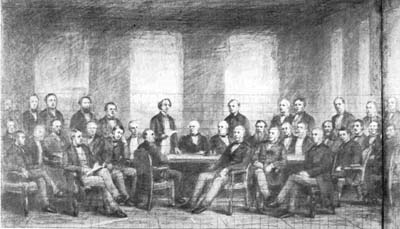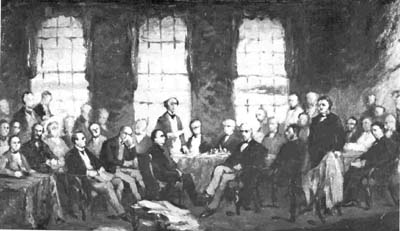
Bulletin 12 (VI:2), 1968
Home
Français
Introduction
History
Annual Index
Author &
Subject
Credits
Contact



Robert
Harris and The Fathers of Confederation
by Moncrieff Williamson
Pages 1
| 2 | 3
| 4
| 5
| 6
Pope's first letter inquiring where the Government could procure a
copy of the original painting referred to a copy in the Royal Alexandra Hotel, Winnipeg. In his reply Harris
wrote:
I am sorry not to have been able to answer your letter sooner,
being puzzled by the mention of a copy of the "Fathers of
Confederation" in the Alexandra Hotel, Winnipeg. Never having
heard of such a thing I waited to write you till could see the C.
P. R. Hotel manager. He assures me no such picture is nor ever was
in the hotel. (19) The architects of the C. P. R. Hotel in Edmonton
tell me that a decorative painting pasted on one of the walls was
made from my picture, but as far as I could learn not faithful to
the original in many particulars and from its position chiefly of a
decorative character, the heads of the figures being about twenty
feet from the floor. A photograph of my painting mechanically
enlarged seems to have been used in producing it. No copy of the
original painting has ever been made to my knowledge. No honourable
artist would have attempted to make a copy without communicating
with me.
(20)
Robert Harris began the task of reconstructing the historic meeting
of the Fathers after he had returned to Charlottetown in June 1883.
A year rater he recorded in his sitters' book: "May 17, 1884.
In Ottawa delivered the large picture of Quebec Conference to the
Minister of Public Works. Saw it safely in the frame in the
Parliament Buildings." (The previous month the painting had
been exhibited at the Royal Canadian Academy, Montreal. It was never to be seen outside
Ottawa again except in 1910 when it was included in an exhibition of
Canadian art at the Walker Art Gallery, Liverpool, England.)
On 23 June 1884, without specifying the actual measurements of
either the canvas or frame, Messrs. Wm. Scott and Son,
Montreal, submitted their account to the Government for $275.25
"for frame of picture painted by R. Harris (Quebec Conference)
and packing same."
Although Harris had seen the original Fathers during their
Charlottetown visit (he was fifteen years old at the time and played
in the orchestra performing for them), his memory of the occasion
must have been slight. Certainly he could not have been expected to
remember their physical appearance. First then, having visited the
site at Quebec as the setting for the painting, he made the
following penciled notes (undated): "Room in Parliament
Building. Back window looked on river on Grand Battery. Chairman
with back to river on window. Curtains on window. Same small table
in room at which they sat."
As an artist skilled in composition, Harris had soon dealt with the
setting, though the surviving preliminary sketches (figs. 3, 4, 5)
(21) indicate that he attempted variations in the composition, one
version of which shows the Delegates outside on the Battery (?),
with Sir John A. Macdonald facing west.
The main difficulty was not in composition, but in the assembling of
information about the Fathers. Harris's most valuable sources were
existing photographs either by William Notman or the firm of Notman
and Sandham, or from the studio of the Court Photographer, Mr.
Topley of 104 Sparks Street, Ottawa; but several of the photographs
showed the Fathers as older men than they had been at the time of
the Conference. To get further information, Harris prepared a
handwritten questionnaire which he enclosed with a personal letter
sent individually to the Delegates or their surviving families. The
questions were along the following lines:
Is the colour in face even/y distributed?
Is there there rouch colour in cheeks? nose? lips? chin?
In the forehead much lighter than rest of face?
When not black, what colour clothes worn?
When colured cravat, what colour?
Hands, large or small?
General remarks.
Of the thirty-three questionnaires sent out only twenty brought
replies. From the surviving ones, it would appear that all the
Fathers wore black and that all but one wore black cravats, the lone
exception wearing grey ones.
The questions were, of course, those that any trained portraitist
would ask himself, but to ask others to seek back in their memories
over twenty years meant that there would be inevitable inaccuracies
which had to be cross-checked with other sources. "The head of
P. E. I. Gray in the cartoon is as he was at the conference wearing
more beard than when I painted him, "wrote Harris to Mr. Roy F.
Fleming, (22) and it would appear that he had several other
last-minute adjustments to make, which in turn altered the tonal
quality of the composition. Only a skilled painter could have
preserved this constant balance, and there must have been
innumerable occasions when Harris felt tempted to throw in the
brush.
Typical of the completed questionnaires with the working notes which
Harris added for his own guidance is that pertaining to the Hon.
George Brown, which is quoted in full:
Armchairs (23)
Incident room (24)
Quebec
Geo. Brown, Sr. Personal details
Black coat
Shade wan enough under lid. Colour
a little
Height 5.10
Eyes blue green
Dark little pores (pupils)
Hair originally dark, but not black Eyebrows not brown
General complexion rather warm. Not too red - but warm.
Colour in more a little lips. A little colour shave
marks.
Shown a little. Little colour in corner of eye.
In nose, colour a notch - a bridge -
a little ear - lip a little.
In addition to the pictorial problems of tone and colour and of
generally bringing the scene to life, Harris had to take certain
liberties with the positioning of the figures. Hector Langevin,
George Brown and T. Darcy McGee occupied the three armchairs. Sir
John A. Macdonald is naturally the central figure, but what about
Tupper, for example? "You ask me about the Fathers of
Confederation picture," Harris wrote to his sister Sarah,
"as to the figure of Tupper. He is, of course, as I had him in
my first drawing for the picture. I put him where he stands, because
I felt that he was going to be very prominent and in that position
he draws the regard of several men towards him." (25)
Next Page | Final
composition
1
| 2 | 3
| 4
| 5
| 6
Annual Index | Author & Subject | Credits | Contact
This digital collection
was produced under contract to Canada's Digital Collections program,
Industry Canada.
"Digital
Collections Program, Copyright
© National Gallery of
Canada 2001"